How to Start Sales Conversations: A Detailed Guide
Explore key strategies for nurturing sales conversations, including building rapport, understanding customer needs and effective closing techniques to boost your sales success.

Explore key strategies for nurturing sales conversations, including building rapport, understanding customer needs and effective closing techniques to boost your sales success.

Prospective customers are inundated with sales pitches, making it challenging for businesses to stand out and forge meaningful connections. Many struggle to engage potential clients, leading to missed opportunities and stagnant growth. Only 13% of customers believe a sales representative can understand their needs.
A well-executed sales conversation can be the key to overcoming the hurdle. The dialogues help businesses cut through the noise by prioritizing genuine relationships and understanding customer needs. Let us explore the fundamentals of sales conversations, their benefits and how to initiate them effectively. We’ll also share best practices to elevate your sales approach, enabling you to connect with prospects deeply and drive conversions.
A sales conversation refers to a purposeful dialogue a business has with its customer, designed to uncover the customer’s needs and demonstrate how a product or service can meet those needs. It plays a vital role in the sales process, bridging the gap between first contact and closing the deal.
The conversation starts with rapport-building and discovery, where the salesperson asks insightful questions to understand the prospect’s challenges. The information helps tailor the presentation, emphasizing specific features and benefits that resonate with the customer. Throughout the dialogue, the salesperson addresses concerns, overcomes objections and guides the prospect toward a confident purchasing decision.
Key objectives:
Be it a face-to-face meeting, a phone call, or a digital interaction, the sales conversation plays a crucial role in aligning solutions with client goals and driving sustainable growth.
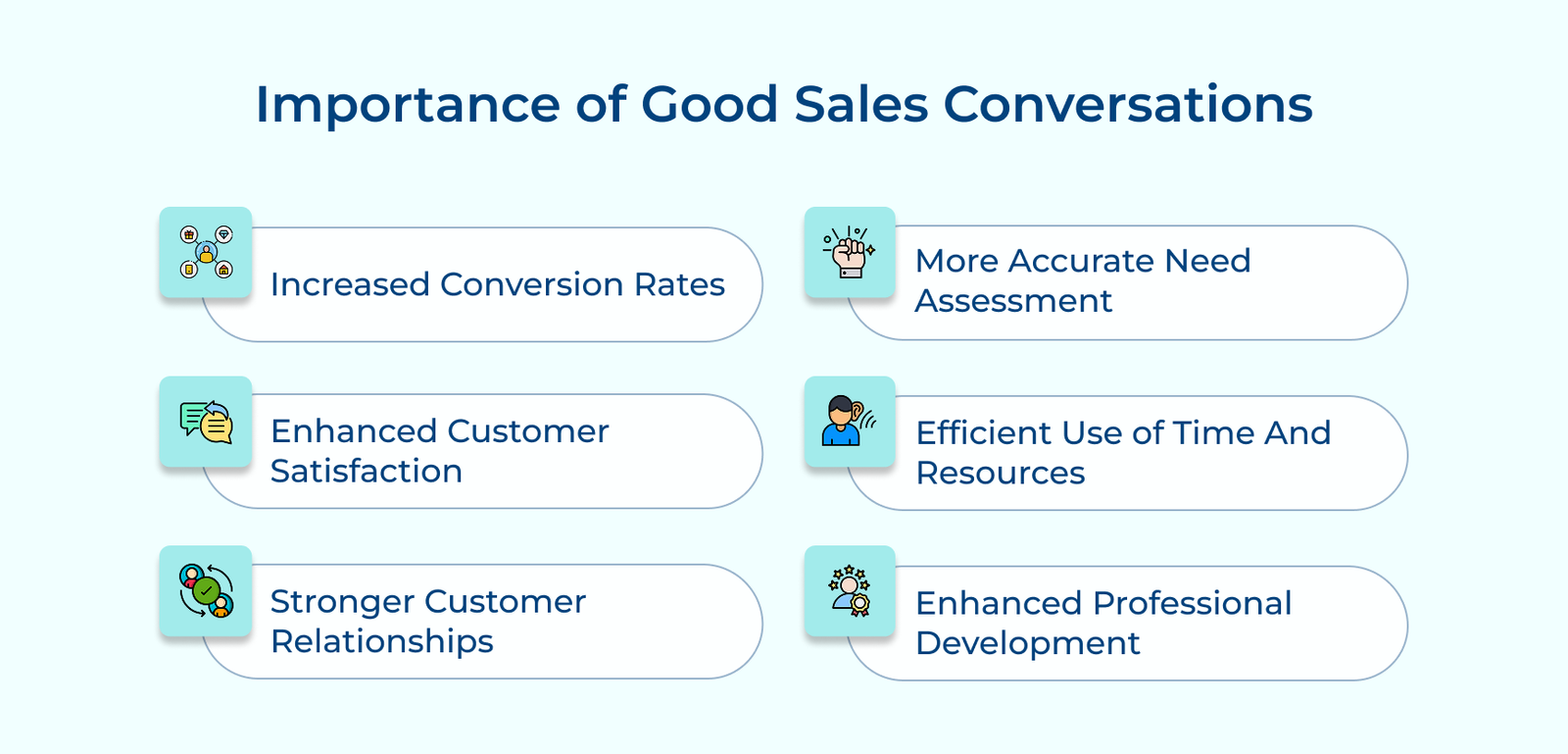
1. Increased conversion rates: Effective sales conversations greatly enhance the chances of converting prospects into customers. Salespeople can showcase the value of their offerings by directly addressing specific needs, resulting in higher conversion rates and improved sales performance.
2. Enhanced customer satisfaction: When a salesperson invests time in understanding a customer’s unique situation and tailors their approach, it creates a personalized experience. The customer-centric focus facilitates higher satisfaction, as clients feel truly heard and valued.
3. Stronger customer relationships: Strong sales conversations establish the foundation for long-term relationships. Salespeople can build rapport that goes beyond the initial sale by promoting open communication, paving the way for repeat business, referrals and lasting brand loyalty.
4. More accurate need assessment: Salespeople can uncover a customer’s genuine needs by employing skillful questioning and active listening. A deeper understanding enables more effective product recommendations, resulting in successful outcomes for both the salesperson and the customer.
5. Efficient use of time and resources: Effective sales conversations enable salespeople to quickly qualify leads and concentrate on the most promising opportunities. The targeted strategy saves time and resources, boosting the efficiency of sales teams.
6. Enhanced professional development: Engaging in high-quality sales conversations sharpens salespeople’s communication skills, emotional intelligence and product knowledge. The ongoing development enhances current performance and paves the way for long-term career growth.
Below are the six essential skills that can transform your conversations and drive your success in the competitive sales landscape.
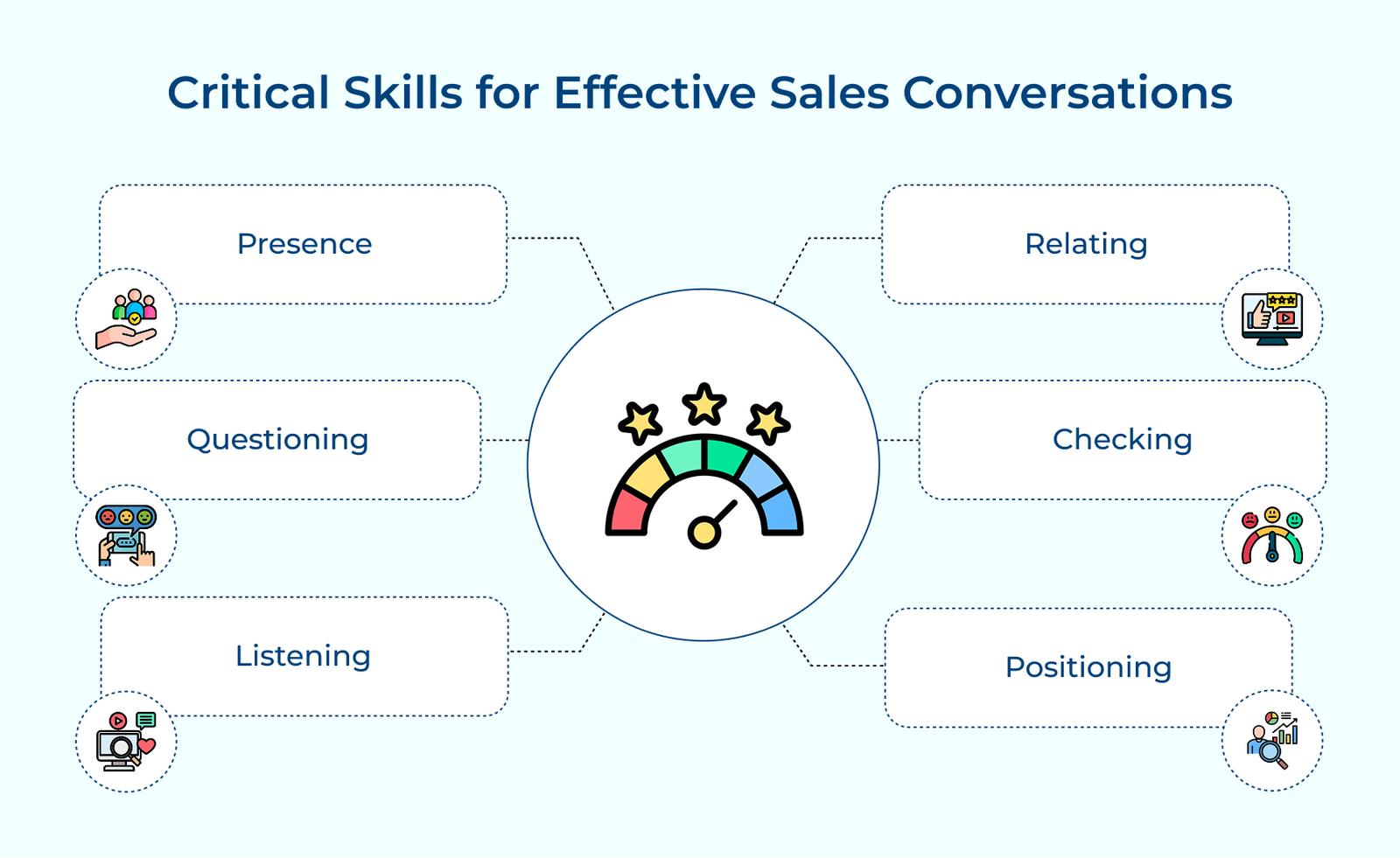
Presence in sales means being fully engaged, confident and authentic during customer interactions. It involves projecting professionalism while staying approachable and genuine. A strong presence establishes credibility and trust, crucial elements for successful sales conversations.
Example: A salesperson maintains eye contact, uses open body language and speaks confidently about their product. The compelling presence captures the customer’s attention and conveys expertise, making them more receptive to the sales pitch.
Checking involves routinely confirming understanding and agreement during the sales conversation. The practice keeps both parties aligned, clarifies misunderstandings and steers the dialogue toward a mutually beneficial outcome.
Example: The salesperson summarizes key points and asks, “Have I captured your main concerns accurately?” The checking technique promotes clarity, demonstrates attentiveness and enables immediate clarification, ensuring the sales conversation stays on course.
Effective questioning involves asking thoughtful, probing questions to uncover the customer’s needs, challenges and goals. It’s about guiding the conversation to gather crucial information while demonstrating genuine interest in the customer’s situation.
Example: Instead of immediately pitching a product, the salesperson asks open-ended questions about the customer’s business challenges. The approach reveals key pain points, allowing for a more targeted and effective sales presentation.
Active listening is more than just hearing words, it requires fully concentrating on the customer’s message and responding thoughtfully. The skill is vital for accurately understanding customer needs and building trust. 46% of buyers agree that “active listening” is the number one skill they expect from sales professionals.
Example: The salesperson listens carefully to the customer’s concerns about implementation costs, takes notes and asks clarifying questions. It shows respect and enables a more tailored response to address specific worries.
Relating involves connecting with customers personally, finding common ground and building rapport. It requires empathy, adaptability and the ability to adjust communication styles to fit different personalities.
Example: The salesperson spots the customer’s sports team logo and casually discusses recent games before transitioning to business. The rapport-building approach makes the customer feel more comfortable and open to the sales conversation.
Positioning is the art of presenting products or services in a way that aligns with the customer’s needs and desires. It focuses on highlighting relevant features and benefits that directly address their pain points or goals.
Example: After discovering the customer’s efficiency challenges, the salesperson positions their software as a time-saving solution, emphasizing specific features that streamline the most time-consuming tasks. The targeted approach resonates powerfully with the customer.
Let us explore the best strategies that will help businesses kickstart their sales conversations and turn prospects into loyal customers.
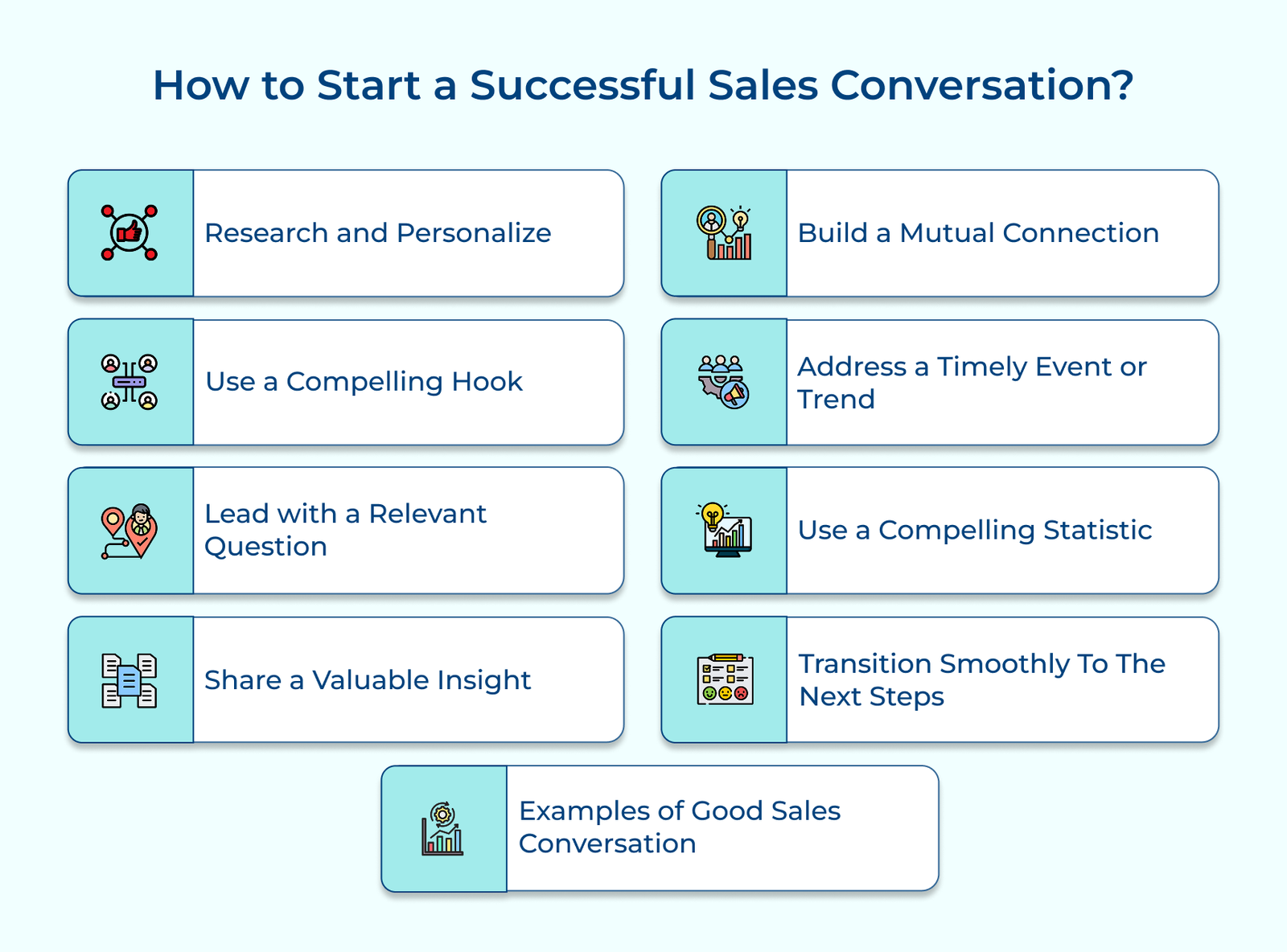
You can tailor your approach to address their specific needs by gathering insights about your prospect’s company, industry and background. The preparation showcases your commitment and professionalism, setting the stage for a productive conversation.
Personalizing your opening remarks based on the research establishes an immediate connection. Referencing relevant details about their business or recent achievements demonstrates genuine interest and creates a customized experience, increasing engagement.
Pro Tips:
A sales hook is an attention-grabbing opening statement or question designed to engage the prospect and spark their interest. Effective hooks can be thought-provoking, surprising or directly address a pain point, setting the tone for a meaningful conversation.
There are several types of hooks, such as statistical hooks, story-based hooks and problem-solution hooks. Let’s assume that you might start with a compelling industry statistic, share a brief success story from a similar client or highlight a common challenge your product addresses. The key is to select a hook that resonates with your specific prospect.
Actionable Tips:
Starting your sales conversation with a thoughtful, relevant question can instantly engage your prospect and encourage active participation. You can show genuine interest in their needs and position yourself as a consultative partner, not just a salesperson by asking the right questions.
Consider your prospect’s industry, challenges and goals to craft effective, thought-provoking questions. Focus on open-ended questions that invite detailed responses and enhance a dialogue. The approach not only helps you gather valuable insights but also builds rapport and trust with your prospect.
How to Implement:
Offering immediate value at the beginning of your sales conversation establishes your credibility and expertise. You showcase your knowledge of the prospect’s industry and position yourself as a valuable resource by sharing relevant insight.
The insights you can share may include industry trends, best practices or little-known facts that affect their business. You create a compelling reason for them to continue the conversation and explore how your offering can meet their needs by linking the insights to the prospect’s specific situation.
Pro Tips:
Leveraging mutual connections can greatly enhance your credibility and increase a prospect’s receptivity to your message. You can establish trust by mentioning shared contacts or networks, helping to overcome initial skepticism and paving the way for more meaningful conversations.
When referencing mutual connections, do so tactfully and authentically. Focus on how the shared connection relates to the value you offer, rather than simply name-dropping. The strategy utilizes social proof, showing that others in the prospect’s network have found value in your expertise or offerings.
Pro Tips:
Staying updated on industry trends and events enables you to align your offering with the prospect’s immediate concerns. You showcase your awareness of their business environment and position your product or service as a timely solution by referencing recent developments.
The strategy establishes relevance and demonstrates your understanding of the prospect’s context. You can create a sense of urgency and highlight the value of taking action now rather than later by connecting current events or trends to your offering.
Pro Tips:
Data-driven insights enhance your credibility and help quantify the potential impact of your offering. You can create a compelling case for further discussion by selecting statistics that resonate with your prospect’s situation.
Choose those that are both impressive and directly relevant to the prospect’s challenges or goals. You can demonstrate how your product or service can address tangible issues or opportunities in their business by linking the statistics to their specific circumstances.
Pro Tips:
As you wrap up your initial sales conversation, summarize the key points discussed and clearly articulate your value proposition. The recap reinforces the most important aspects and ensures the prospect understands how your offering can benefit them.
Proposing a clear next action is vital for maintaining momentum. If it’s scheduling a more in-depth demonstration, providing additional information or arranging a meeting with decision-makers, be specific about the next steps. Seek agreement on moving forward to ensure both parties are aligned on the path ahead.
Actionable Tips:
Following are a few practical examples of good sales conversations that not only capture attention but also enhance lasting relationships with clients.
1. “I noticed your company recently expanded into [new market]. How has this affected your [relevant business process]?”
The opener shows that you’ve researched the prospect’s company and are aware of their recent developments. It reflects genuine interest in their business situation and encourages them to share their experiences.
You pave the way for a meaningful conversation about potential challenges or opportunities by highlighting a specific aspect of their business. It can naturally lead to discussing how your product or service could be beneficial in their new market.
2. “Many [industry] leaders are grappling with [specific challenge]. Is this something your team has been facing as well?”
The opener taps into industry knowledge to create common ground, positioning you as someone who understands the broader context of the prospect’s business environment and the challenges they face.
You invite the prospect to share their experiences by framing it as a question, helping you confirm your assumptions about their challenges and allowing you to tailor your approach.
3. “I recently read an interesting report about [industry trend]. It suggested that [statistic or finding]. What’s your take on this?”
The opener showcases your industry knowledge and encourages the prospect to engage in a meaningful discussion. It indicates that you’re informed about current trends and value their expert opinion.
You frame the conversation as a dialogue between peers rather than a sales pitch by seeking their perspective. The approach helps build rapport and establishes your credibility as a knowledgeable partner.
4. “[Mutual connection] mentioned that you’re doing innovative work in [area]. I’d love to hear more about your approach.”
The opener uses a mutual connection to quickly build trust and credibility. It demonstrates that you’ve done your homework and have a genuine interest in the prospect’s work.
You invite them to share their expertise by expressing curiosity about their approach. It can lead to a more open and engaging conversation, allowing you to identify how your product or service might add value.
5. “Congratulations on your recent [achievement or award]. How has this impacted your strategy for [relevant area of business]?”
The opener begins the conversation on a positive note by recognizing a recent success. It shows that you’re attentive to the prospect’s company and genuinely interested in their progress.
You create an opportunity to discuss their current strategies and plans by connecting their achievement to a specific area of their business. It can smoothly lead to exploring how your offering might support their continued success.
Here are some common mistakes to watch out for during your conversations to increase your chances of success:
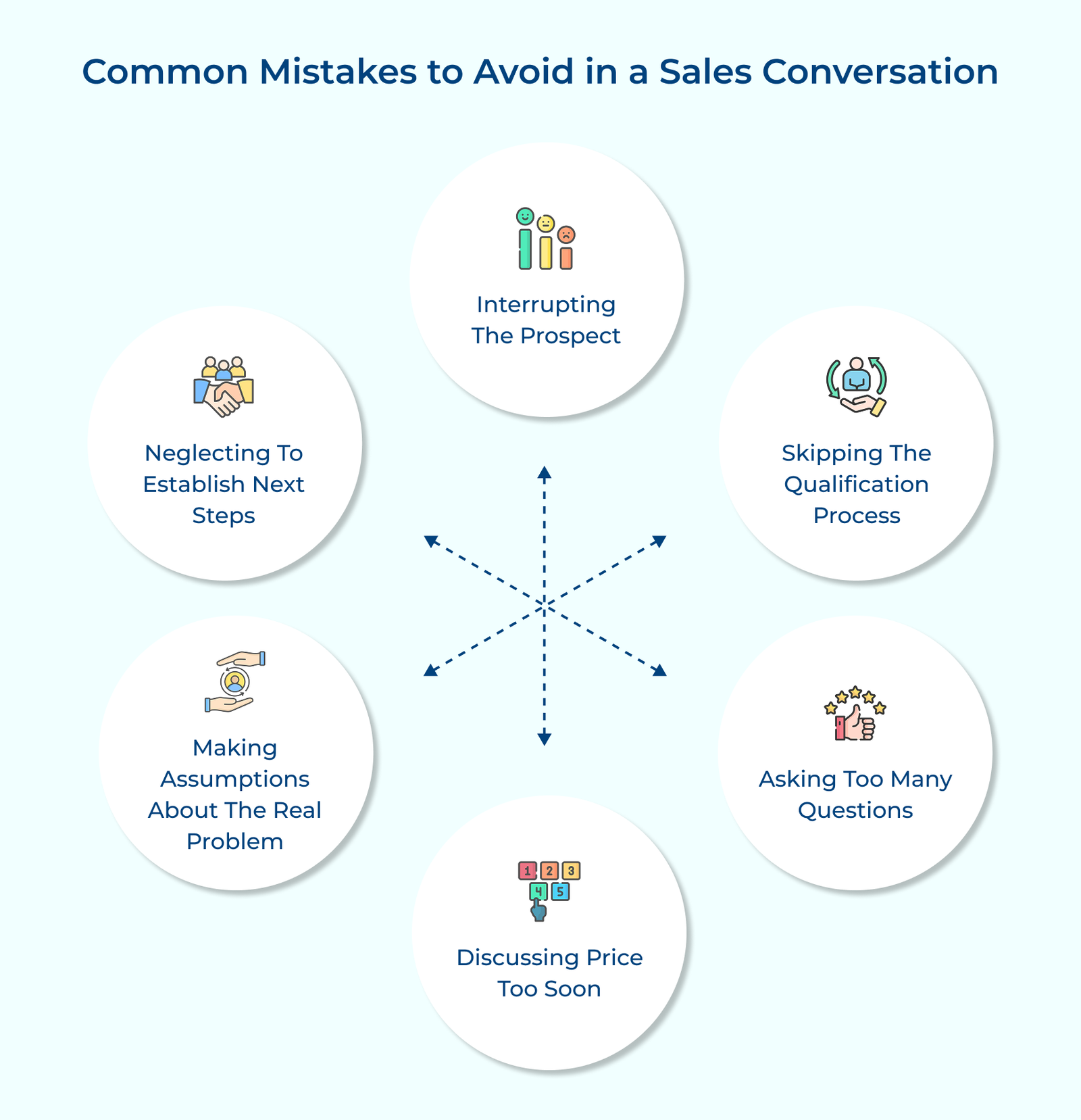
1. Interrupting The Prospect
Interrupting the prospect is a common mistake that can undermine the rapport you’re trying to build. It demonstrates a lack of respect for their thoughts and can make them feel unheard or undervalued, leading to frustration.
Practice active listening by allowing the prospect to finish their thoughts before you respond. Use non-verbal cues like nodding and maintaining eye contact to show engagement. When you do speak, paraphrase their points to confirm understanding and demonstrate that you were truly listening.
2. Skipping The Qualification Process
Skipping the qualification process can waste time and resources on prospects who aren’t a good fit for your product or service. Without proper qualification, you risk investing effort in a sales process with someone lacking the budget, authority, need or timeline to buy.
Create a systematic qualification process using frameworks like BANT (Budget, Authority, Need, Timeline) or GPCT (Goals, Plans, Challenges, Timeline). Seamlessly incorporate qualification questions into your conversations to focus on prospects with the highest potential for conversion.
3. Asking Too Many Questions
While asking questions is essential for understanding a prospect’s needs, too many can make the conversation feel like an interrogation. It can overwhelm the prospect, create defensiveness and disrupt the natural flow, leaving little room for you to provide value or showcase your solution.
Instead, focus on high-quality, open-ended questions that yield valuable insights. Limit yourself to 3-5 key questions per conversation stage. Balance your questioning with active listening and relevant information about your offering to create a more natural, dialogue-driven interaction.
4. Discussing Price Too Soon
Bringing up prices too early can derail the sales process. Without first establishing value and understanding the prospect’s needs, discussing cost can lead to sticker shock or premature objections, shifting focus away from the benefits of your offering.
Prioritize building value first. Understand the prospect’s needs, pain points and goals before mentioning price. When you do discuss pricing, frame it in terms of return on investment or cost savings. The approach helps the prospect recognize the value of your offering relative to its cost.
5. Making Assumptions About The Real Problem
Assuming you know the prospect’s real problem without thorough exploration can result in misaligned solutions and wasted efforts. It may also make the prospect feel misunderstood and diminish credibility.
Use probing questions to delve deeper into their situation. Don’t take initial statements at face value—often, the first issue mentioned isn’t the root cause. Employ techniques like the “5 Whys” to uncover underlying problems. The approach shows your commitment to truly understanding and addressing their needs.
6. Neglecting to Establish Next Steps
Ending a sales conversation without clear next steps can result in lost momentum and missed opportunities. It leaves the prospect uncertain about what to expect, making follow-up challenging and risking promising leads falling through the cracks.
Always conclude each conversation by agreeing on specific next steps. If it’s scheduling another call, sending additional information or arranging a product demo, be clear about your actions, what you need from them and the timeline. It keeps the momentum going and sets clear expectations for moving forward.
Ready to transform your conversations into lasting partnerships? Explore the best practices that set top-performing sales professionals apart!
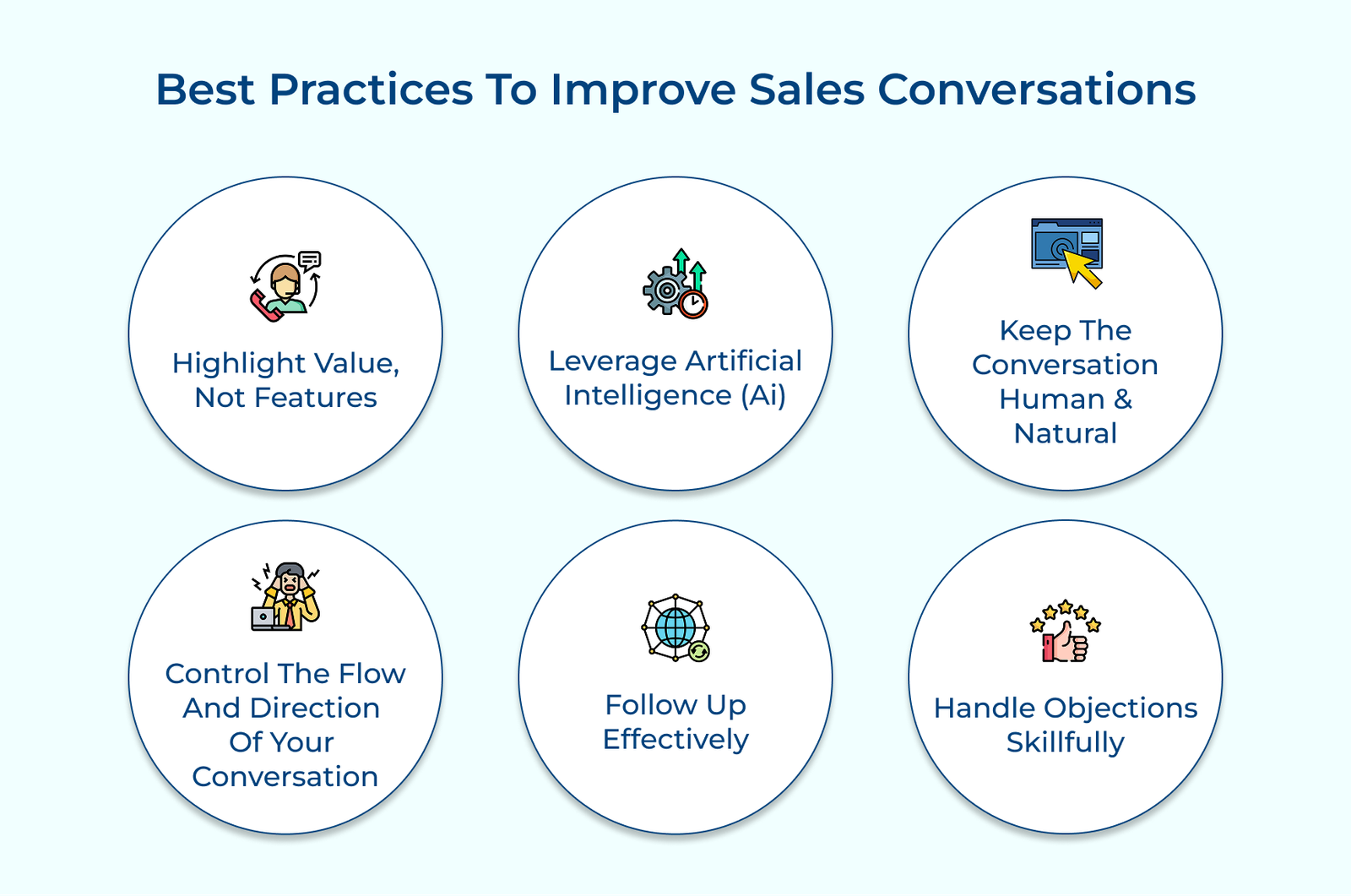
Emphasize the tangible benefits and outcomes your product or service delivers instead of simply listing its features. Explain how your offering solves specific problems or helps achieve particular goals, as the approach resonates more with prospects by directly addressing their needs.
Let’s assume that instead of saying, “Our software has an automated reporting feature,” say, “Our software saves you 10 hours a week on report generation, freeing you up for strategic decision-making.”
Leverage AI-powered tools to elevate your sales conversations. AI can deliver real-time insights, suggest relevant talking points and assist with call analysis afterward, helping you personalize your approach throughout the sales process.
Use AI for lead scoring, predictive analytics or chatbots to engage prospects initially. The tools enable you to concentrate on the most promising opportunities and tailor your strategy more effectively.
While utilizing technology is essential, maintaining a human touch is equally crucial. Avoid sounding scripted or robotic, instead, aim for a natural, conversational tone that builds rapport and trust. Show empathy, incorporate appropriate humor and be yourself.
Practice active listening and respond genuinely to the prospect’s comments. The human approach enhances a connection that goes beyond business, paving the way for long-term customer loyalty.
Guide the conversation toward your objectives while staying adaptable to the prospect’s needs. Use a structured approach, like the SPIN (Situation, Problem, Implication, Need-payoff) technique, to cover key points and gather essential information.
Have transition phrases ready to steer the conversation back on track if it strays. Let’s consider that you might say, “That’s an interesting point. How does it connect to your main goal of [previously discussed objective]?”
Create a systematic follow-up approach that includes sending recap emails after conversations, sharing relevant resources and maintaining regular touchpoints. Be persistent yet respectful, always adding value to your follow-ups.
Utilize a CRM system to track interactions and set reminders for follow-ups. Personalize your messages based on previous conversations to demonstrate that you remember and care about their specific situation.
Treat objections as opportunities to clarify and showcase value rather than as roadblocks. Build a repertoire of responses to common objections, but always customize your approach to the specific situation.
Employ the LAER method (Listen, Acknowledge, Explore, Respond): Listen attentively to the objection, acknowledge its validity, explore the underlying concern with questions and then respond with a solution or clarification. The respectful approach addresses the prospect’s concerns effectively.
Effective sales conversation strategies are essential. They help companies connect with potential customers, understand their needs and present tailored solutions that drive conversions. Mastering the techniques enables businesses to stand out and forge lasting client relationships.
Sales teams can boost conversion rates, enhance customer satisfaction and cultivate brand loyalty by implementing the strategies. Clear communication of value propositions, confident handling of objections and personalized approaches lead to a more efficient sales process.
Key takeaways:
Effective sales conversations drive revenue by uncovering customer needs, building trust and offering tailored solutions. They enable salespeople to showcase value, address objections and guide prospects to informed decisions. Well-executed dialogues result in higher conversion rates, larger deal sizes and greater customer loyalty, fueling revenue growth.
Key elements of effective sales conversations include active listening, asking insightful questions, showcasing product knowledge, confidently addressing objections, sharing relevant stories, leveraging social proof, maintaining a positive tone and guiding the conversation structure.
Keep sales conversations engaging by adopting a natural, conversational tone. Use storytelling to illustrate your points and ask thought-provoking questions that prompt the prospect to reflect on their challenges. Share relevant insights or industry trends and respond to their cues. Incorporate visual aids when appropriate and maintain enthusiasm throughout the discussion.
Address objections by actively listening and acknowledging the prospect’s concerns. Use clarifying questions to uncover the root of the issue, then respond with relevant information, case studies or testimonials that directly address their worries. Reframe objections as opportunities to add value and maintain a calm demeanor throughout the discussion.
Close the sales conversation by summarizing the key points and value propositions discussed. Emphasize how your solution meets their specific needs, then confidently ask for the sale using assumptive language. If they’re not ready to buy, establish clear next steps, such as scheduling a follow-up meeting or product demo.

Market better, sell faster and support smarter with Veemo’s Conversation Customer Engagement suite of products.
Unify all your customer data in one platform to deliver contextual responses. Get a 360 degree view of the customer lifecycle without switching tools.
Connect with the tools you love to reduce manual activities and sync your business workflows for a seamless experience.
 https://veemo.io/wp-content/uploads/2024/12/customer-service-response-time.png
1256
2400
Webvision Solution
https://veemo.io/wp-content/uploads/2024/11/veemo.svg
Webvision Solution2025-10-17 10:51:142025-10-17 10:51:149 Effective Tips to Reduce Customer Service Response Time
https://veemo.io/wp-content/uploads/2024/12/customer-service-response-time.png
1256
2400
Webvision Solution
https://veemo.io/wp-content/uploads/2024/11/veemo.svg
Webvision Solution2025-10-17 10:51:142025-10-17 10:51:149 Effective Tips to Reduce Customer Service Response Time https://veemo.io/wp-content/uploads/2024/10/How-to-Create-Knowledge-Base.png
1257
2400
Vikas Sachan
https://veemo.io/wp-content/uploads/2024/11/veemo.svg
Vikas Sachan2024-10-21 12:24:342025-11-03 07:13:21How to Create a Knowledge Base in 9 Easy Steps: The Ultimate Guide
https://veemo.io/wp-content/uploads/2024/10/How-to-Create-Knowledge-Base.png
1257
2400
Vikas Sachan
https://veemo.io/wp-content/uploads/2024/11/veemo.svg
Vikas Sachan2024-10-21 12:24:342025-11-03 07:13:21How to Create a Knowledge Base in 9 Easy Steps: The Ultimate Guide https://veemo.io/wp-content/uploads/2024/02/Live-Chat-for-Sales.png
628
1200
teamwebvisionsolution@gmail.com
https://veemo.io/wp-content/uploads/2024/11/veemo.svg
teamwebvisionsolution@gmail.com2024-10-21 11:31:222025-08-06 10:22:06How to Use Live Chat for Sales? 7 Proven Ways to Grow Revenue
https://veemo.io/wp-content/uploads/2024/02/Live-Chat-for-Sales.png
628
1200
teamwebvisionsolution@gmail.com
https://veemo.io/wp-content/uploads/2024/11/veemo.svg
teamwebvisionsolution@gmail.com2024-10-21 11:31:222025-08-06 10:22:06How to Use Live Chat for Sales? 7 Proven Ways to Grow RevenueGrow Customer Relationships and stronger team collaboration with our range of products across the Conversational Engagement Suite.

 How to Handle Abusive Customers: 8 Effective Tips
Scroll to top
How to Handle Abusive Customers: 8 Effective Tips
Scroll to top